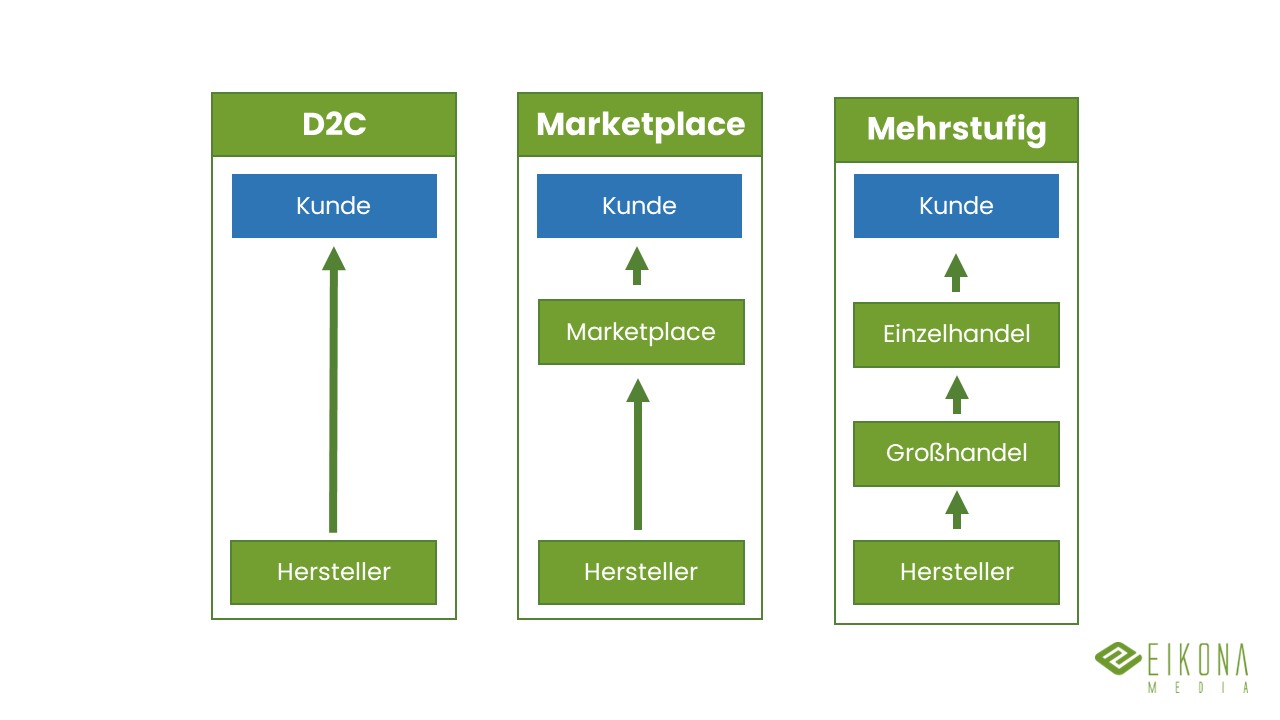D2C - Direct to Consumer - Strategy, Elements, Successes

You want to enter the D2C space with your product or brand but are not sure if it suits your business? In this post, we have examined this trending topic in detail and provide you with a comprehensive overview below.
What is D2C – Direct to Consumer?
In essence, the translation already describes what Direct-to-Consumer (D2C) shops are: these are shops operated by manufacturers that target end consumers directly. In this model, wholesale and retail intermediaries are bypassed, and products are sold directly to consumers. Similar practices exist in traditional retail as well. There have long been companies that exclusively sell to end customers in this manner. However, it is often one of the distribution channels for products. For instance, Mary Kay exclusively sells its cosmetic products directly. Many brands also operate flagship stores where they showcase and sell their products directly to consumers. Well-known examples include Apple or various clothing manufacturers. Of course, these manufacturers still sell through other distribution channels – D2C is not the sole distribution method.
However, a significantly larger number of companies enter the online market for end consumers because the barriers to entry are lower, and there are relevant strategic reasons for direct selling.
D2C – Direct to Consumer Strategie
Now you might be wondering: Why are D2C shops increasingly being operated, and why don't manufacturers simply place advertising and product information on their websites? One answer to this question could be that taking this step and achieving higher gross profits has become much easier than it was a few years ago. However, relying solely on this opportunity-oriented argument may not be sufficient. In the past, the risks were often associated with trade and its functions. The hypothesis was: If we sell directly to end consumers online, we will gain less than we lose because retailers will no longer list our products, resulting in revenue losses. You must assess this for your company yourself. Allow us to provide a suggestion: Revenue losses are usually overestimated.
Currently, the situation is different than it was, for example, 10 years ago. Manufacturers now have to manage their product data on online marketplaces, and many retailers, especially in the clothing industry, are going bankrupt. Revenue is declining in brick-and-mortar retail, and online, manufacturers have already established the necessary logistics capacities through widely used dropshipping. The step to approach end customers directly is therefore not far, and the opportunities often outweigh the risks. So, in general, you now have more opportunities than risks with D2C.
Additionally, there are several relevant benefits for you: In addition to the already mentioned higher gross profit, you also gain plenty of customer data. When customers buy directly from you, you can, with their consent, reach out to them. You can obtain their consent, for example, by offering a voucher for the first purchase when the customer subscribes to a newsletter. After that, you can highlight new products at any time and create stronger brand loyalty with customers than is possible through intermediaries. Furthermore, you can run tests on your website to find out which content configuration yields the highest returns. You can then apply these insights to marketplaces. Overall, you have more control over your customer communication efforts.
What are the prerequisites for D2C commerce?
Selling directly over the Internet as a manufacturer is attractive – it promises higher gross profits, allows you to better understand your customers, and enables you to bind them directly to your brand. However, it is helpful if you already have experience in online business. We will explain the prerequisites for you here.
Foundation: The D2C Webshop
Of course, you need your own webshop if you want to sell directly to end customers. In this case, it is helpful if you already sell to B2B customers or distribute your products through online retail: In these cases, you already have e-commerce experience, and you will have your product data available in a form that allows you to populate an online shop with product data. You may need to align your communication more with end customers and communicate more benefits.
Logistics: The D2C Journey to the Customer
With a D2C shop, the number of shipments your warehouse needs to pick will significantly increase. Are you prepared for this, or do you need to invest more here? If your warehouse is already working with dropshipping, i.e., with direct deliveries, then transitioning to sending directly to end customers is a small step. In the case of dropshipping, this is done on behalf of a retailer, and you send the customer order that came through a retailer directly to the end customer. In this case, you would already have experience in sending packages to consumers.
However, this alone is not sufficient for the D2C business. Unfortunately, customers will also return items – returns. There will be far more returns than you are used to from the B2B business. Be prepared for this, and remember: the better your product data, the lower the rate of returns.
If all of this seems overwhelming to you, there are also fulfillment service providers. They act immediately after an order is placed and take care of warehousing, picking, packing, shipping, and returns processing.
D2C Customer Service
In traditional retail, retailers handle many service functions for you. However, you might already have a customer service department that answers questions. In this case, you may need to expand and offer additional service capabilities. One keyword in this area is "assembly service."
Advertising & Social Media: D2C Customer Communication
Brands have been communicating with their customers through various media channels for many decades—print, radio, television, etc. When it comes to consumer goods, customers typically make their purchases through retailers. However, in the case of D2C (Direct-to-Consumer) shops, customers buy directly from the manufacturer. This requires promotional measures. Whether these measures are specifically created for the online shop or if the brand's web address is mentioned in traditional advertising, it doesn't matter. It's gratifying to note that within your brand-building efforts on social media, you can directly generate sales and engage with your customers. Other forms of online advertising, especially retention measures, are also necessary. For instance, product registrations, contests, or discount codes can contribute to brand loyalty. It doesn't matter through which channel the product was purchased.
Summary
Direct to Consumer
D2C stands for Direct to Consumer. It involves online shops operated by manufacturers that directly target end consumers. This allows manufacturers to generate higher gross profits for products sold through these channels. Additionally, it enables manufacturers to build stronger connections with customers and offset revenue losses due to declines in traditional retail.

